Key Takeaways
- Transaction Overload occurs when transaction volume exceeds the network's capacity, leading to processing delays.
- Limited Block Space is a primary cause, as each block can only hold about 1 MB of data.
- Increased Fees and Delays are direct results, as users pay more for faster transaction confirmation.
What is Blockchain Network Congestion?
Think of the Bitcoin network as a digital highway with a fixed number of lanes. When transaction volume surges, it's like rush hour traffic—more transactions than the network can handle at once. This creates a backlog because each new block can only fit about 1 MB of data, leaving many transactions waiting in a queue, known as the mempool.
To get ahead in this digital traffic jam, users compete for priority by paying higher transaction fees, measured in satoshis per virtual byte (sats/vB). A standard transaction fee might jump tenfold during peak periods, such as during a popular BRC-20 token mint. This bidding war means only the highest bidders get their transactions confirmed quickly, while others face significant delays.
Causes of Blockchain Network Congestion
Network congestion isn't random; it stems from specific limitations and demand spikes. Understanding these triggers is key to grasping the network's operational dynamics and its scalability challenges. Several factors contribute to these digital traffic jams.
- Demand: Sudden increases in transaction volume, often from new applications or market speculation.
- Block Size: A fixed limit on how much data each block can contain, creating a natural bottleneck.
- Block Time: The set interval between the creation of new blocks, which restricts processing speed.
- Spam: Low-fee, high-volume transactions that can flood the network and crowd out legitimate ones.
- Fee Markets: Bidding wars for transaction priority that intensify during periods of high demand.
Impacts of Blockchain Network Congestion on Transactions
When the network is congested, transaction fees skyrocket as users bid against each other for limited block space. This pricing pressure makes small payments impractical, forcing users to either pay high fees or endure long confirmation times. The user experience degrades significantly as a result, making the network less accessible for everyday use.
This environment creates a two-tiered system where only high-value transfers are viable, undermining the goal of a decentralized financial network. Persistent congestion also makes the network unreliable for time-sensitive applications. It highlights the critical scalability problem that must be solved for broader adoption.
How Blockchain Network Congestion Affects Fees
When network traffic surges, the demand for limited block space creates a competitive fee market. Users must outbid one another to ensure their transactions are processed promptly, directly linking network congestion to transaction costs. This dynamic makes fees volatile and often unpredictable.
- Fee Spikes: Sudden, sharp increases in transaction costs during high-demand periods.
- Bidding Wars: Users compete by offering higher fees to miners for faster confirmation.
- Cost Volatility: Fees become unpredictable, making it difficult to forecast transaction expenses.
- Economic Viability: High fees can render small, everyday payments economically impractical.
Strategies to Mitigate Blockchain Network Congestion
Developers are building solutions to improve scalability and address network congestion. These approaches range from protocol upgrades to off-chain systems, each with distinct trade-offs for improving transaction throughput.
- Upgrades: Protocol changes like SegWit increase block capacity but require widespread, slow-to-achieve consensus.
- Sidechains: Linked blockchains offer greater speed but introduce new security considerations and trust assumptions.
- Layer-2s: Networks like Lightning process transactions off-chain for speed and low fees, though they add complexity for users.
Future Solutions for Blockchain Network Congestion
This is how the network will scale to meet future demand.
- Implement core protocol improvements to increase the base layer's transaction capacity.
- Expand Layer-2 networks, moving the bulk of transactions off the main chain for faster, cheaper processing.
- Introduce sharding to partition the network, allowing parallel transaction processing and boosting overall throughput.
- Foster ecosystem-wide adoption of new standards and technologies to create a unified, high-performance network.
The Lightning Network: Bypassing Main-Chain Congestion
The Lightning Network operates as a second layer on top of Bitcoin, creating a system of off-chain payment channels. By moving transactions off the main blockchain, it sidesteps the block size limits and processing delays that cause congestion. Users can conduct numerous transactions instantly with minimal fees. These transactions are only settled on the main chain when a payment channel is closed, bundling many small transfers into two on-chain transactions. This approach dramatically increases the network's capacity and makes micropayments practical.
Join The Money Grid
You can access the full potential of digital money by connecting to a global payments network built on Bitcoin’s foundation. Lightspark’s Money Grid uses the Lightning Network to provide instant, low-cost transfers, moving your transactions off the congested main chain for reliable, real-time settlement.


